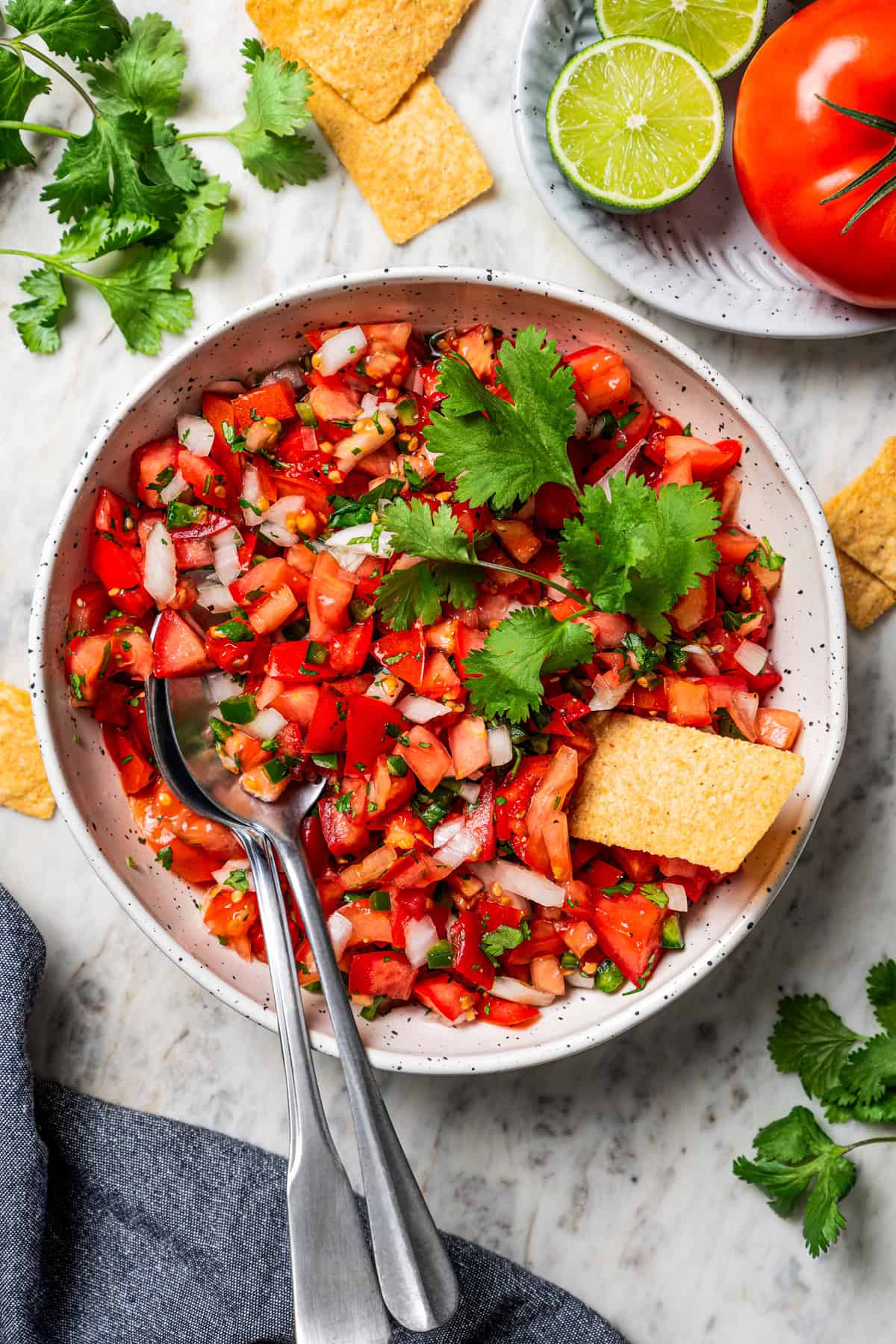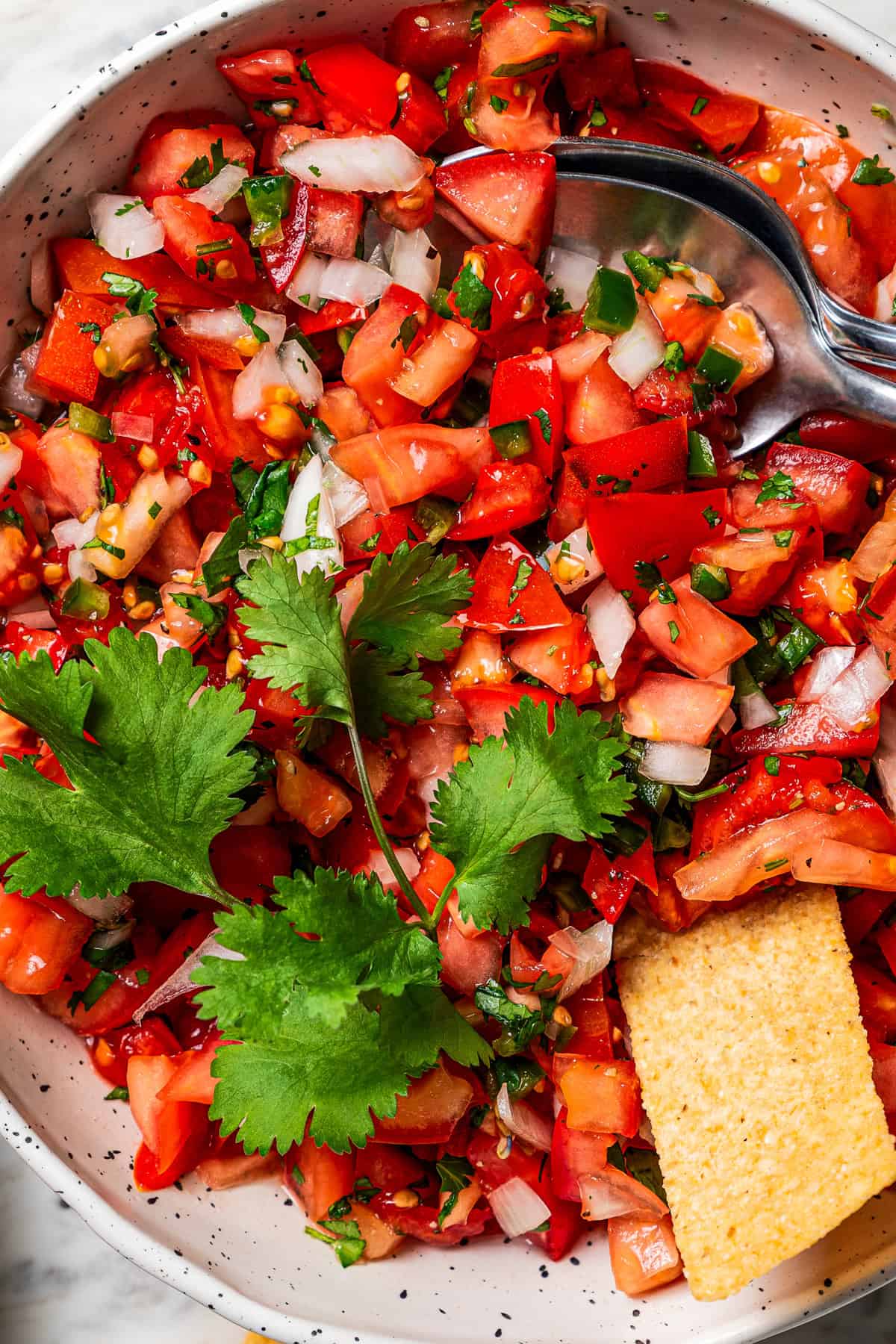I’ll show you how to make fresh and authentic pico de gallo with only 5 ingredients: tomatoes, onion, jalapeño, cilantro, and lime. It’s quick and easy!
Mexican pico de gallo, or salsa fresca, isn’t just for dipping tortilla chips! I always find new ways to obsess over this homemade recipe, from garnishing a walking taco casserole to piling it into a pulled chicken taco.

Pico de gallo is a fresh tomato salsa from Mexican cuisine. Whenever we eat out at our local Tex-Mex restaurant, I dive into a big bowl of pico de gallo and load it onto crunchy tortilla chips. I’ll be on my second bowl before my husband reminds me we’re there to eat a meal, not just salsa and chips. I can’t help it. I LOVE pico de gallo, and once I started making it at home, it was endgame. With tomato season upon us, there’s no better time to make it than the present.
Why This Pico de Gallo Recipe Is a Keeper
- Fresh flavors. Traditional Mexican pico de gallo has just 5 simple ingredients: a base of finely diced tomatoes, onion, and jalapeño tossed with fresh lime juice and chopped cilantro. Once you’ve fallen in love with the basics, there are plenty of possibilities for add-ins, like mango and pineapple!
- It’s easy to make. With a little chopping and marinating, this Mexican tomato dip is the perfect anytime condiment. Make it in minutes!
- Versatile. Pair it with just about any Tex-Mex and Mexican dish under the sun. Serve it as a dip, or use it to add delicious fresh, chunky texture to everything from tacos to nachos, migas, enchiladas, grilling recipes, taco bowls, and more.

You’ll Need These Fresh Ingredients
Apart from salt and pepper, you need just five ingredients to make traditional homemade pico de gallo (pronounced pee-koh day guy-oh). I’ve covered these below, along with some notes and substitutions. Scroll to the recipe card for the printable details, amounts, and a step-by-step with photos at the bottom of the post.
- Tomatoes – The better quality tomatoes, the better your dip will taste. Red, ripe Roma (plum) tomatoes are a good choice, but use the best tomatoes you can find. If Roma tomatoes aren’t in season, cherry tomatoes are a good backup!
- Onion – Finely diced. Choose an onion you’d use for salads, like sweet Vidalia or white onion. Red onion also works well.
- Jalapeño – Remove the ribs and seeds to avoid an overly fiery salsa. Serrano peppers or habanero peppers are good alternatives. If you’re sensitive to spice, however, feel free to omit the chili pepper.
- Lime Juice – Freshly squeezed. Skip the bottled stuff! You’ll need 1-2 limes to make 3 tablespoons of juice.
- Cilantro – Fun fact: There’s a genetic variation that makes cilantro taste like soap for some people. For this reason, it can be a controversial ingredient! If you’re one of them, swap it for freshly chopped parsley instead.
What’s the Difference Between Pico de Gallo and Salsa?
The main difference between the two is the preparation method. Salsa often uses cooked tomatoes that are crushed to be more similar to a purée. Meanwhile, pico de gallo always uses fresh, raw ingredients, with less liquid and a chunkier texture. I usually serve them as a dip trio with guacamole, and both go great with tacos and more.

Ways to Use It
Use your homemade pico de gallo the same way you’d use salsa as a condiment. Serve it alongside your next batch of sizzling steak fajitas or use it as a topping for tacos. It’s also great on any of the following:
Of course, it’s always a tasty appetizer with tortilla chips! If you’re looking for another fun way to serve this tomato dip, pile it onto a tostada (basically, a flat taco) or add it to crostini for Tex-Mex bruschetta.

Tips for the Best Pico de Gallo
- Use ripe tomatoes. The theme here is FRESH, so when you can, make this recipe when tomatoes are in season. Underripe, pink, or hard tomatoes aren’t great candidates for pico de gallo. Choose the best ripe tomatoes available.
- Deseed the tomatoes. If you have time, it’s worthwhile to remove the tomato seeds before you chop them for an even better texture. However, it’s not mandatory!
- Dice everything very fine. Chop your tomato, onion, and jalapeño nice and fine. This way, you’ll end up with a good mix of everything in every bite.
- Rest the salsa before serving. Let the ingredients mingle and marinate for 15-20 minutes before you dig in. It also gives the salt a chance to draw out excess moisture. You can make this recipe the day before you plan to serve it, and let it rest overnight in the fridge.
- Scoop it with a fork or slotted spoon. As the tomatoes release their moisture, you’ll notice liquid pooling at the bottom of the bowl. To avoid making your tacos, nachos (etc.) soggy, serve the pico de gallo with a slotted spoon so the liquid gets left behind. I’ll sometimes mix the leftover sauce into salad dressings or soups.
Frequently Asked Questions
If you translate it directly, pico de gallo means “beak of rooster” in Spanish. However, the recipe doesn’t have anything to do with birds or roosters. Some sources say it’s because people would pick at the salsa with their fingers when eating, like a rooster would pluck with its beak!
Generally speaking, authentic pico de gallo has a little heat from the chili peppers, but it isn’t fiery hot. Removing the ribs and seeds from the peppers helps tame the spice. Otherwise, the beauty of making it at home is that you can make it as spicy or mild as you’d like! Skip the peppers if you’d prefer a mild salsa, or add more if you crave the flame.
Pico de gallo has a lot less liquid than salsa. So, while you can absolutely use it interchangeably as a dip for tortilla chips or as a topping for dishes, I wouldn’t substitute it in all recipes that call for salsa. For example, if a cooking method relies on the liquid in salsa (like, say, salsa chicken or slow cooker pulled chicken), you should not swap it for pico de gallo. Save your pico as a topping instead!

Pin this now to find it later
-
Combine the ingredients. In a bowl, combine the diced tomatoes, onions, jalapeno, salt, and pepper. Let it sit for about 5 minutes.
-
Add lime juice. Stir in the lime juice and cilantro and toss to combine. Taste and adjust accordingly.
-
Marinate, then serve. Let it rest for about 15 to 20 minutes before serving. You can also refrigerate it, covered, for up to 4 days.
- You can omit the jalapeño if you are sensitive to spice.
Calories: 29kcal | Carbohydrates: 7g | Protein: 1g | Fat: 0.3g | Saturated Fat: 0.04g | Polyunsaturated Fat: 0.1g | Monounsaturated Fat: 0.04g | Sodium: 201mg | Potassium: 311mg | Fiber: 2g | Sugar: 4g | Vitamin A: 1064IU | Vitamin C: 22mg | Calcium: 17mg | Iron: 0.4mg
Nutritional info is an estimate and provided as courtesy. Values may vary according to the ingredients and tools used. Please use your preferred nutritional calculator for more detailed info.
How to Make Classic Pico de Gallo (Salsa Fresca)
Here’s how to make this popular tomato salsa in 3 steps:
Easy Add-Ins
One of my favorite ways to adapt this recipe is to swap the tomatoes for another fruit, like mango, pineapple, peaches, or strawberries. Other tasty add-ins are diced bell peppers, sweet corn, and avocado. Try my other easy salsa variations that riff off of pico de gallo:
Storing Leftovers
- Keep your salsa covered in the fridge for up to 4 days. I don’t recommend freezing fresh salsa as it’ll become mush when it’s thawed.




